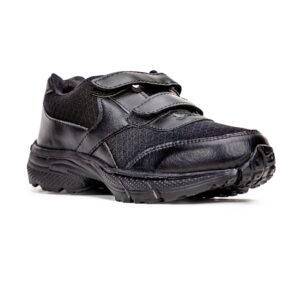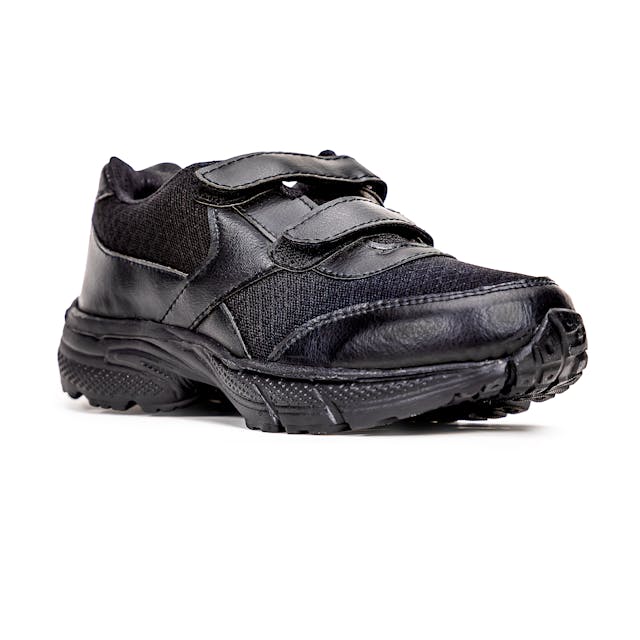
How does Velcro work? Velcro consists of two pieces of tape. One side has hooks and the other side has loops. When you put them together, the hooks get caught in the loops and hold the two pieces of tape together.
Velcro is a brand name, but it has become synonymous with the product, just like Frisbees, aspirin, and bubble wrap. The name was coined by George de Mestral when he invented the product in 1941. He combined the French words “velours”, which means velvet, and “crochet”, which means hook. Velvet Hook is a very nice sounding name. He came up with the idea when he was walking his dog in the Swiss Alps. He got home, and his dog was covered in the burrs of the burdock plant, which had hooked onto his dog’s fur coat. He analyzed the properties of the burrs and realized he could make something similar. The burr had hundreds of thin spines, and each one had a tiny hook on the end of it. Everywhere that his dog’s hair was twisted into a loop, the hook had latched on. The burrs had evolved to do this as a way to disperse their seeds. The burr is full of seeds, and when it is ripe, only loosely attached to the plant. The hooks latch onto the fur of a passing anima,l and they are pulled from the plant. The idea is for them to be able to grip to the animal well enough that they can be carried away, but not so well that they never fall off. After a while, they will be scraped off against a tree or rock, and they will fall to the ground. Then they can release their seeds, and the burdock has managed to spread to a new area. This hook and loop system seemed ideal to George de Mestral because it was strong enough to fasten, but not so strong that it couldn’t be undone.
Mestral spent a long time trying to work out how to make his new idea. Hook and loop things did already exist, but there was always one loop for each hook, and they were lined up with each other. Mestral wanted to make a product where there were hundreds of hooks and hundreds of loops that could attach in any way and in any direction. His first problem was the material. In 1941, he was limited to cotton, which was thin enough to make the hooks and loops. The trouble was, it was difficult to make stiff hooks, and the loops frayed too easily. He tried other things, and just before World War 2, a synthetic material called nylon had been invented. This was perfect for his needs. It was thin, stiff, yet also flexible. All he needed to do was to work out how to produce it. It took him ten years to come up with a machine that could make the material. The mesh of loops was the easy part. He just needed to weave a mesh of thin nylon strands that were tangled because they would automatically make loops, just like the fur on his dog. The hook part took longer. He finally worked out that when he sewed thicker nylon thread into loops under infrared light, they would stiffen. He could then use a machine to cut all of the hardened loops open, which would leave lots of stiff hooks that could become enmeshed in the loops and were strong enough to be fastened and pulled apart many times.
Once he had his machines ready to go, Mestral patented his Velcro and got ready for a rush of demand. After all, it was far easier to use than buttons and zips. It is hard to put ourselves in the minds of people in the 1950s, faced with this new product. For us, it is everywhere. Just glancing around myself now, I have Velcro on my shoes, on my watch strap, on my rucksack, tying up my computer cables, and on my hat. First, Mestral couldn’t find anyone to produce the Velcro for him because they didn’t think there would be any demand for it. Once he found a distributor, he couldn’t find anyone to buy it. The material looked unprofessional, and people couldn’t see the use of it. Obviously, it took off, but its path to popularity was an odd one. The first people to take it up were NASA for their astronauts. Zips and buttons are too fiddly when you are wearing a spacesuit, but Velcro is not. From there, it was taken up by SCUBA divers because their getup is similar to that of astronauts. Then, luckily for us, children’s clothing manufacturers saw Velcro being used to hold bags to the wall in the space shuttle, and they realized how useful it could be to help children who weren’t yet dexterous enough to use zips and buttons dress. Once it had made the jump to children’s clothing, it didn’t take long for Velcro to be everywhere. George de Mestral became very wealthy from his invention. And this is what I learned today.
Sources
https://www.hookandloop.com/blog/what-is-hook-loop-made-of
https://en.wikipedia.org/wiki/Hook-and-loop_fastener
https://en.wikipedia.org/wiki/George_de_Mestral
https://en.wikipedia.org/wiki/Bur
https://en.wikipedia.org/wiki/Nylon
https://invention.si.edu/invention-stories/george-de-mestral-velcror-inventor
https://www.thoughtco.com/the-invention-of-velcro-4066111
Photo by Anil Sharma : https://www.pexels.com/photo/black-velcro-strap-athletic-shoe-on-white-background-30641951/

